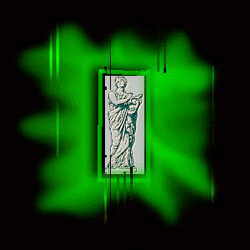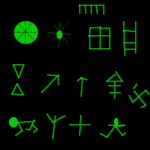
A
King he was on a carven throne
In many-pillared halls of stone
With golden roof and
silver floor
And runes of power upon the door
J.R.R. Tolkien
The Fellowship of the Ring
The influence of the Runes on their time is incontestable. Elliot notes that when the high chieftains and wise counselors of Anglo-Saxon England met in conclave, they called their secret deliberations "Runes". and that when Bishop Wulfila made his translations of the Bible into fourth century Gothic, he rendered St. Mark's "The mystery of the kingdom of God" (Mark 4:11) using RUNA for mystery." Eight centuries earlier, when the Greek historian Herodotus travelled around the Black Sea, he encountered descendants of Scythian tribesmen who crawled under blankets, smoked themselves into a stupor and then cast sticks in the air and "read" them when they fell. Although these tribesmen were preliterate, their sticks would probably qualify as Runes. There is no firm agreement among scholars as to where and when runic writing first made its appearance in Western Europe. Symbols scratched in rocks are dated from the Bronze age, common in Sweden and were probably linked to Indo-European fertility and sun cults.

The carvings include representation of men and animals, parts of the human body, weapon motifs, sun symbols, the swastika and variations on square and circular forms. Elliott suggests an amalgamation of two separate traditions, "the alphabetic script on the one hand, the symbolic content on the other." Numerous Hallristningar, as well as the runic standing stones can still be seen in the British Isles, in Germany and throughout Scandinavia. The Rune casters of the Teutons and Vikings wore startling garb that made them easily recognizable. Honoured, welcomed, feared, these shamans were familiar figures in tribal circles. There is evidence that a fair number of runic practitioners were women. The anomynous author of the thirteenth century SAGA OF ERIK THE RED provides a vivid description of a contemporary mistress of rune craft:
Click above to continue
or